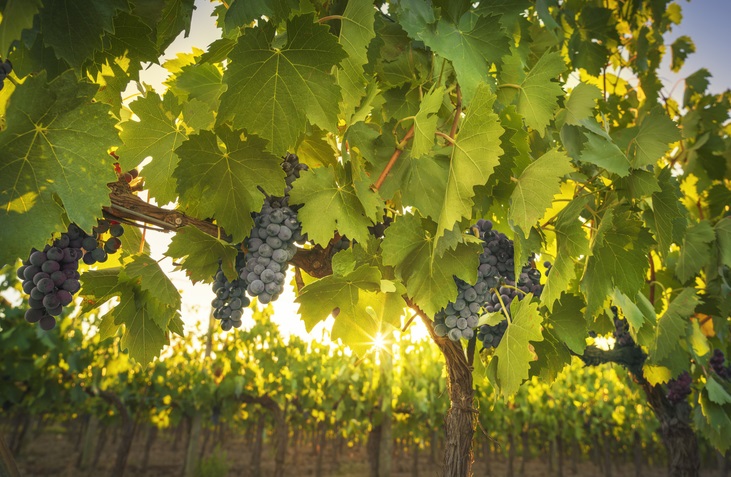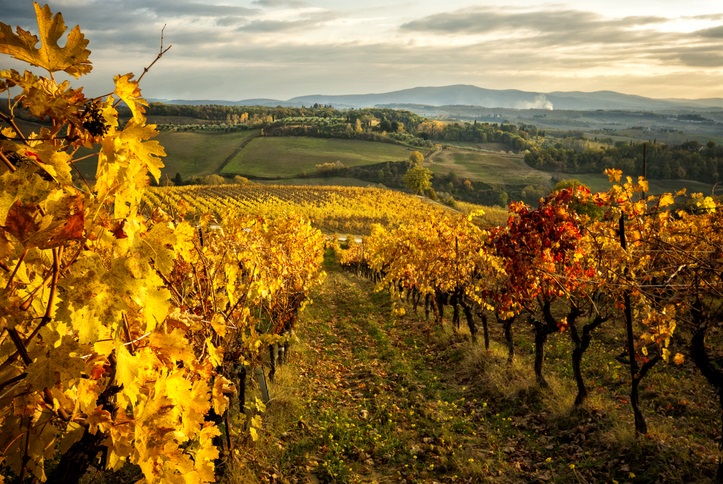Sangiovese Grape Characteristics & Wine Profile
Last Updated on April 3, 2023.
Sangiovese is a blue-black grape variety that is primarily used to produce red wine. It’s always been synonymous with Italy, and most notably, Tuscany, where the grape is believed to have originated from.
IN THIS GUIDE:
- Taste
- Pairings
- Terroir
- Aging
- Wine Recommendations
- …and more
Sangiovese is a perplexing grape variety, in that there are many clones and sub-types that are sometimes mistakenly referred to by its general denomination. It is the dominant variety in a number of Italian wines, usually named after their DOCG. In terms of wine styles, this variety is used in numerous red wine blends, especially Chianti.
There are at least 14 Sangiovese clones that we know of. The most important one worth knowing is Brunello di Montalcino, which is one of Italy’s most famous wines.
For a time, Brunello was considered a separate grape variety. A deeper look at the grape’s genetics revealed it too was Sangiovese. In 1980 Brunello di Montalcino was granted the controlled designation of origin guaranteed (DOCG), where this particular Tuscan region is known to produce Italy’s finest wines.
Notable Sangiovese Clones and Sub-Types are:
- Brunello of Montalcino (Clone)
- Sangiovese Grosso (also called Dolce, or Gentile)
- Sangiovese Piccolo
What Does Sangiovese Taste Like?
Sangiovese typically displays red fruit notes like red currant, ripe red cherry, cranberry, tomato, and strawberry. Earth and herbal notes can include limestone, tea leaf, forest floor, tobacco, mushroom, thyme, cracked red pepper, saddle leather, smoke, and herbs.
The Sangiovese grape adds gorgeous acidic structure and backbone when blended with a multitude of grapes, but it takes a skilled winemaker to master its use as the sole variety in a wine. Sangiovese vines tend to adapt to both hot and cold climates, and these various terroir-related adaptations can have a substantial impact on the aromatic and flavor profile of Sangiovese wine.
Sangiovese Food Pairings
It’s impossible to talk about Italy’s signature grape without mentioning the food! Sangiovese loves the dishes from its homeland, from pizza to pasta with tomato-based sauces to osso buco.
Sangiovese works well with cheeses because of its relatively high acidity levels, and it also can work with spicier dishes like barbecue. For vegetarian dishes, lean towards eggplant and lentils to allow Sangiovese to shine.
Climate and Terroir for Sangiovese
While Sangiovese is grown extensively in Italy, other old-world countries within Europe grow a much smaller percentage of the vine.
On the other hand, Sangiovese has been found to grow very well in some new world environments, particularly in Argentina, Texas, and California, where it responds well to the climate and limestone makeup of their respective terroirs. Limestone in particular seems to enhance the wine’s unique mineral and earthy kick.
Sangiovese wine comes from high-yielding grape vines that thrive in porous, well-drained soil. Vines are often planted in shallow soil. Because the grape is usually high-yield, its quality can vary starkly. Sangiovese can grow vigorously, and in hot climates it’s not uncommon for over 15 tons per acre of Sangiovese grapes to be produced.
These intense yields can sometimes lead to late-ripening and vitiate the quality of the end product. An imbalance in crop load will almost always delay ripening and result in a poor acidic and sugar balance. If you come across a good quality Sangiovese or Sangiovese blend, you can be fairly sure the winemaker is highly skilled.
How is Sangiovese Aged?
Sangiovese is acidic, which means it can age very well. Brunello, for example, can age for decades on end and become richer and more mellow with time. Sangiovese can handle various types of oak treatment but the best help soften the acid without overwhelming the fruit with oak. More inexpensive Sangioveses are meant to be drunk young, though even those tend to fare well longer than they’re supposed to.
Be sure to try some of these fantastic Sangiovese wines from around the world:
- Altesino, ‘Montosoli,’ Brunello di Montelcino
- Felsina, Chianti Classico Riserva, Tuscany, Italy
- Viticcio, Morellino di Scansano, Tuscany, Italy
- Clos Canarelli, Corse Figari Rouge, Corsica, France
- Foxen 7200, ‘Volpino,’, Santa Ynez Valley, Santa Barbara County, California
- Vino Noceto, Amador, Sierra Foothills, California
Learn About These Other Wine Grape Varieties
Written By Jamie Metzgar
Jamie Elizabeth Metzgar began her career in wine by pouring in a tasting room on the East End of Long Island, NY. After moving to New York City, she landed a position at Chambers Street Wines where she was encouraged to pursue wine education at the Wine & Spirits Education Trust (WSET). She earned Level III certification there and has since earned California Wine Appellation Specialist and Certified Specialist of Wine certifications as well. After way too many moves, she has recently landed in Northern California where she is compiling an unofficial roster of dog-friendly tasting rooms.
Fruit
Red (Red Currant, Ripe Cherry, Cranberry, Tomato, Strawberry)
Earth & Mineral Notes
Limestone, Tea Leaf, Forest Floor
Additional Complexities
Tobacco, Mushroom, Thyme, Cracked Red Pepper, Leather Saddle, Smoke, Herbs
Sangiovese Grape Characteristics
Structure & Body
Body Medium
Sugar Dry
Tannins High
Acid High
Alcohol Medium-High (12.5%-14.5% ABV)
Finish Medium-Long, Spicy, Acidic

